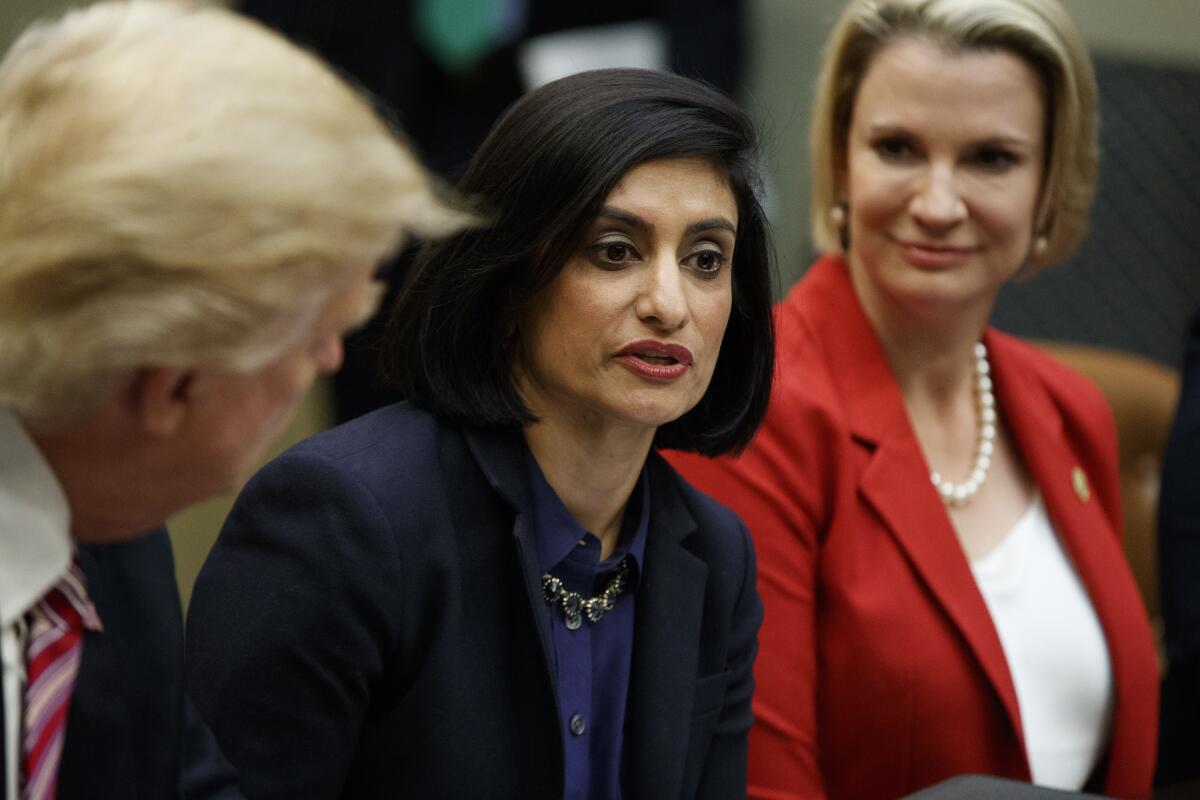Editorial: Trump offers the wrong fix for Medicaid’s shortcomings

- Share via
Medicaid, the government health insurance program for the poor, is one of the costliest, if not the costliest, program that states operate. Total Medicaid spending by states and the federal government, which covers more than 60% of the claims, neared $600 billion in fiscal 2018; in California alone last year, Medicaid spending topped $100 billion.
One reason the program is so pricey is the vast number of people it covers: more than 71 million as of October, or roughly one of every five Americans. But in numerous states, particularly in the South and Midwest, Medicaid doesn’t reach as many people with subsistence-level incomes as it should, especially able-bodied adults with incomes just above the federal poverty level.
On Thursday, the Trump administration took steps that could affect whether and how states cover those residents. It offered states more freedom from cumbersome federal Medicaid mandates in exchange for the states shouldering more of the financial risk. Specifically, Washington would no longer promise to pick up 50% to 90% of those individuals’ healthcare costs; instead, it would give states a lump sum each year, based either on previous spending levels or the number of people enrolled. If a state spent less than its block grant, it would be allowed to keep some of the money to invest in other aspects of its Medicaid program; if it spent more, it would have to absorb the loss.
Republicans have been pushing for years to convert all of Medicaid to block grants, but as a way to control costs, not to expand coverage. And when Republicans controlled both chambers of Congress and the White House in 2017 and 2018, they voted on several proposals to do just that, none of which passed. And that’s a good thing; such ham-fisted efforts to cut spending and cover fewer people would have betrayed Medicaid’s mission of providing quality healthcare to Americans too poor to afford private insurance coverage.
The initiative the administration unveiled Thursday, which carries the Orwellian moniker “Healthy Adult Opportunity,” is far more modest. Exempting the impoverished parents, children, pregnant women, elderly and disabled people covered by a state’s traditional Medicaid plan, it would apply only to able-bodied adults under 65 who are either impoverished but childless or somewhat less poor, regardless of family size. That’s much of the same group targeted by the 2010 Affordable Care Act, but more than a quarter of the states did not agree to expand their Medicaid programs to cover those adults, despite the help the ACA offered.
The administration’s pitch may be more palatable to these 14 states — as well as the states that did expand their Medicaid programs, but have been daunted by the cost — because it would give them the flexibility to impose a variety of measures to limit spending on the newly covered individuals. These include encouraging people to use more effective forms of care by charging lower copays for them, dropping coverage for some prescription drugs to negotiate better prices, trying out more efficient ways to deliver care, and putting tighter limits on who’s eligible for coverage.
Giving states more flexibility to innovate in pursuit of Medicaid’s mission is undeniably a good thing, which is why the Medicaid statute gives the administration that authority. The challenge, though, is making sure the innovation improves the quality, accessibility and efficiency of the care that poor Americans receive. Otherwise, states will have a powerful incentive to save money simply by providing less care and leaving more people uninsured.
So far, the Trump administration hasn’t met that challenge. It has already encouraged states to apply for waivers to require Medicaid recipients to work or enroll in job training a certain number of hours per month, which is also one of the flexibilities offered by the new initiative. The handful of states that have obtained such waivers, however, have been sued by people who lost coverage, and their courts have been sympathetic to their complaints. That’s because the states’ own data shows that the requirements are expected to drive thousands of people off Medicaid without lifting them out of poverty; instead, most of them will lose eligibility because they fail to comply with the paperwork.
One cannot help but suspect that the initiative unveiled Thursday is a stalking horse for a broader effort to end Medicaid’s guarantee of healthcare for anyone who’s eligible. And that would be painfully shortsighted; it’s more humane and, yes, cost-effective to provide managed and well coordinated care to low-income Americans than to treat them for acute, costly problems in the emergency room. Rising healthcare costs are a problem for everyone in America, not just taxpayers and Medicaid enrollees. We should be exploring ways to cut costs by getting more bang for our healthcare bucks, rather than denying care to people at the bottom of the economic ladder.
More to Read
A cure for the common opinion
Get thought-provoking perspectives with our weekly newsletter.
You may occasionally receive promotional content from the Los Angeles Times.










